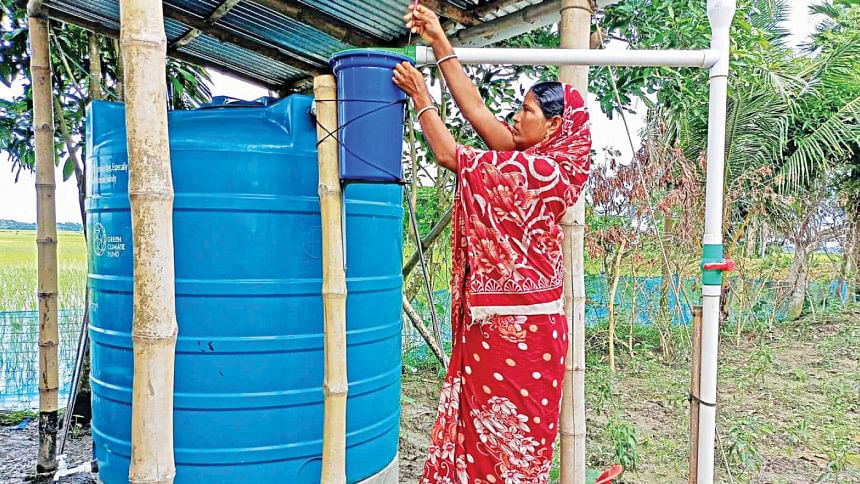Rainwater harvesting is the sustainable answer for coastal water scarcity

"Water for Peace" is the theme of this year's World Water Day. While safe drinking water is accessible in many parts of the country, over 2.5 million people in Bangladesh face formidable challenges due to the excessive salinity in both surface and groundwater. The existing crisis is being worsened by various factors, including the impacts of climate change, disasters like cyclones and tidal surges, development without proper assessment of the fragility of the local environment, and some other natural as well as human-made factors. Our proximity to the Bay of Bengal further compounds the challenges faced by the region.
For generations, Bangladesh has been struggling to find year-round accessible safe drinking water sources, and this issue has been steadily deteriorating due to the rapidly changing climate. As conventional water sources proved insufficient to meet people's demands for year-round supply, there has been a need for improved drinking water systems. Government agencies, along with donors, development agencies, and NGOs swiftly intervened to introduce diverse water sources. Although these initiatives provide clean and safe drinking water, none of them individually ensures year-round access to water.
While high-tech alternative drinking water solutions have significant negative impacts on the environment and climate, rainwater harvesting systems offer an environmentally friendly drinking water solution to the coastal people.
Over the past two decades, as the impacts of climate change have become increasingly visible, various improved water sources have been widely used for accessing drinking water. These sources include shallow and deep tube wells, rainwater harvesting systems, reverse osmosis (RO) plants, pond sand filters (PSF), restricted or managed ponds, and managed aquifer recharge (MAR). Despite the progress, a crucial discussion continues to determine which would be the most appropriate and sustainable water sources taking into account the social, environmental, and economic aspects of the communities residing along the southwestern coast.
To address this pressing question, Multi-criteria Decision Analysis (MCDA) has emerged as a highly effective tool for identifying the finest water sources. This method systematically evaluates critical factors, such as the accessibility of community members to water sources; the reliability, acceptability, and affordability of water sources for local people; the social and environmental impacts of these sources; the sustainability of operations and maintenance of the sources; the potential for technology transfer to marginalised areas; and the availability of spare parts. The respective authorities seek the opinions of local residents through Participatory Rapid Appraisal (PRA) to determine which water sources are convenient for them. Afterwards, they use MCDA to evaluate the suitability of the water sources based on relevant criteria.
By applying MCDA, diverse stakeholders such as the Bangladesh government, the United Nations Development Programme (UNDP), and WaterAid have collaboratively identified an innovative solution to tackle the ongoing challenge of drinking water scarcity in coastal areas. This approach facilitates long-term, sustainable drinking water supplies for the region. Through MCDA, rainwater harvesting emerged as the most suitable and sustainable water source. With the coastal region receiving a considerable annual rainfall of 2,900 mm, of which more than 70 percent graces the land during the monsoon season, the potential to harness this abundant natural resource is inordinate. By preserving and efficiently filtering this natural gift, communities can effectively utilise it during the dry season. Additionally, they can tap into other available water sources that become accessible during this season. Water tanks and pots installed near households ensure easy access for the people, especially women and adolescent girls, who are mainly affected by the burden of collecting drinking water from distant places, constituting more than 80 percent of the total drinking water collectors. This offers them the opportunity to redirect their efforts and time toward other endeavours, thereby paving the way for empowerment and progress.
Affordability stands as a prime determinant in selecting a suitable water source. A 2,000-litre rainwater harvesting system with pre and post-filtration system for a household of an average of five members which ensures water supply for at least six months of the dry period, can cost anywhere between Tk 35,000 and Tk 40,000. Although the price is significantly high, it is vital to recognise that rainwater harvesting is a long-term investment. When compared to the installation cost and maintenance requirements of other drinking water sources, along with the issue of reliability of the water source, rainwater harvesting emerges as a more sustainable option. Furthermore, it is worth noting that currently government agencies, NGOs, and donors are taking the initiative to install these systems on a cooperative and instalment basis, thereby alleviating the financial burden from the coastal communities themselves.
Minimal upkeep costs for cleaning and repairs, coupled with the use of locally available materials for maintenance, make rainwater harvesting systems an even more attractive and sustainable option. By taking the lead on installation, responsible parties like the government, NGOs, and donors can facilitate a smooth technology transfer, making rainwater harvesting readily accessible to communities. Consequently, hassle-free practices, a relatively low-tech approach, and low-cost water supply close to homes have made the rainwater harvesting system socially acceptable and widely embraced by the coastal community. While high-tech alternative drinking water solutions have significant negative impacts on the environment and climate, rainwater harvesting systems offer an environmentally friendly drinking water solution to the coastal people.
However, the quality of harvested water can be compromised due to inadequate knowledge and suboptimal maintenance practices. Therefore, effective Operations and Maintenance (O&M) is crucial for the sustainability of this water source. In practice, while household rainwater harvesting systems benefit from frequent cleaning due to their proximity to homes, community systems often face a lack of engagement in maintenance.
Considering the climatic and environmental conditions of the southwestern coast of Bangladesh, rainwater harvesting has currently proved to be the most practical and sustainable drinking water solution for the area. It directly contributes to achieving Sustainable Development Goals (SDGs), including Goal 6 (Clean Water and Sanitation) and Goal 13 (Climate Action). Therefore, with its potential for long-term sustainability and positive environmental impact, rainwater harvesting offers a promising solution for securing clean drinking water and building resilience against climate change in southwestern Bangladesh, aligning perfectly with the country's SDG aspirations.
Tasneem Chowdhury Fahim is a lecturer at the University of Dhaka.
Md Mainul Islam is a Water and Sanitation Specialist at UNDP Bangladesh.
Views expressed in this article are the author's own.
Follow The Daily Star Opinion on Facebook for the latest opinions, commentaries and analyses by experts and professionals. To contribute your article or letter to The Daily Star Opinion, see our guidelines for submission.

 For all latest news, follow The Daily Star's Google News channel.
For all latest news, follow The Daily Star's Google News channel. 










Comments